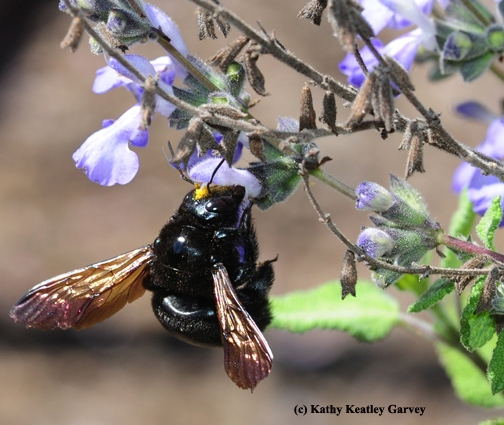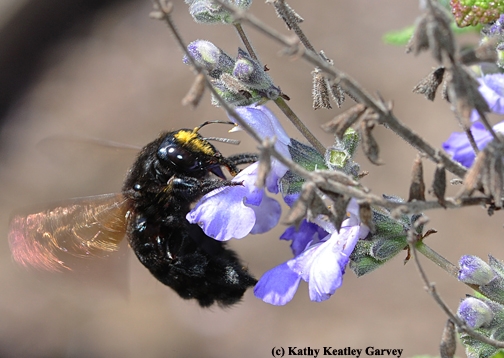Ever watched Valley carpenter bees (Xylocopa varipuncta) foraging on salvia?
Native pollinator specialist Robbin Thorp, distinguished professor of entomology at the University of California, Davis, recently noticed a flurry of carpenter bees in the grape-scented sage, Salvia melissodora, in the Department of Entomology and Nematology's bee garden on Bee Biology Road.
Native bee enthusiast Celeste Ets-Hokin of the Bay Area gifted the plant to him. It is now thriving in the department's half-acre bee friendly garden, the Häagen-Dazs Honey Bee Haven. Planted in 2009, the garden is located on Bee Biology Road, next to the Harry H. Laidlaw Jr. Honey Bee Research Facility, west of the central campus.
When carpenter bees forage on the sage, they receive "pollen deposits" or "pollen caps" on their heads. "A perfect placement spot for pollen transfer from flower to flower," Thorp commented. "It also produces a striking orangish patch on the face of the all black bees."
The female Valley carpenter beesare solid black, while the males (which Thorp calls "teddy bear bees"), are green-eyed blonds.
As for the Salvia melissodora, the name "melissodora" originates from the Greek "Melissa" (honey bee) and "odora" (fragrance).
Mark your calendar for Saturday, May 2. That's when the Department of Entomology and Nematology will celebrate the fifth anniversary of the garden installation. Free and open to the public, the open house will take place from 10 a.m. to 2 p.m. UC Davis bee scientists will be there to help you observe and identify the native bees and provide information on honey bees. Download the flier for more information.
Thanks to a generous gift from Häagen-Dazs, the garden came to life during the term of interim department chair, Professor Lynn Kimsey, director of the Bohart Museum of Entomology, who coordinated the entire project.
A Sausalito team--landscape architects Donald Sibbett and Ann F. Baker, interpretative planner Jessica Brainard and exhibit designer Chika Kurotaki--won the design competition. The judges were Professor Kimsey; founding garden manager Missy Borel (now Missy Borel Gable), then of the California Center for Urban Horticulture (CCUH) at UC Davis and now director of the statewide UC Master Gardeners; David Fujino, executive director, CCHU; Aaron Majors, construction department manager, Cagwin & Dorward Landscape Contractors, based in Novato; Diane McIntyre, senior public relations manager, Häagen-Dazs ice cream; Heath Schenker, professor of environmental design, UC Davis; Jacob Voit, sustainability manager and construction project manager, Cagwin and Dorward Landscape Contractors; and Kathy Keatley Garvey, communications specialist, UC Davis Department of Entomology and Nematology.
Others who played a key role in the founding and "look" of the garden included the UC Davis Art/Science Fusion Program, co-founded and co-directed by the duo of entomologist/artist Diane Ullman, professor and former chair of the UC Davis Department of Entomology (now Department of Entomology and Nematology), and self-described "rock artist" Donna Billick. The ceramic mosaic art is the work of UC Davis Entomology 1 students, taught by Ullman and Billick, and artists from the community. Billick's stunning ceramic bee sculpture of a worker bee, "Miss Bee Haven," anchors the garden. Eagle Scout Derek Tully planned, organized and built a state-of-the-art fence around the garden. Later the California chapter of the Daughters of the America Revolution provided a much-welcomed donation. (Read more about the history of the bee garden here). Chris Casey succeeded Melissa Borel as the manager of garden.
Now five years have come and gone, and generations of bees have come and gone. Life is good.
Attached Images:

A female Valley carpenter bee, Xylocopa varipuncta, forages on grape-scented sage, Salvia melissodora. Note the "pollen cap." (Photo by Kathy Keatley Garvey)

Check out the "pollen cap" on this female Valley carpenter bee, Xylocopa varipuncta, foraging on grape-scented sage, Salvia melissodora. (Photo by Kathy Keatley Garvey)